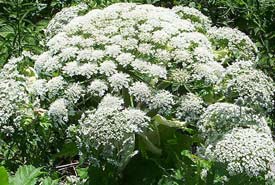
Giant hogweed (Photo by Wikimedia Commons)
Giant hogweed
Giant hogweed is an extremely invasive species that originated from Asia and Eastern Europe. It is a perennial and a member of the carrot and parsley family. Giant hogweed can pose a serious health hazard for humans. If the plant’s watery, clear sap comes into contact with human skin and is then exposed to sunlight, the UV radiation can cause severe burning and weeping blisters.
How is it identified?
The flowers are large umbrella-shaped cluster of small white flowers that closely resemble the wildflower Queen Anne’s Lace (also invasive in North America). The plant grows to impressive heights. Plants can grow as high as two to five and a half metres (15 to 18 feet). It has thick hollow stems and large lobed leaves. The stems are covered with reddish-purple flecks and stiff hairs filled with sap.
How does it grow?
Seeds may take several years to grow and can live in the soil for up to 15 years. Giant hogweed flowers once in its lifetime, unless the flower clusters are damaged before opening. Once the plant produces seeds it dies. Each plant can produce up to 120,000 winged seeds (typically 50,000). Seeds can be spread up to 10 metres by the wind.
Where does it grow?
Giant hogweed has the potential to spread readily and grows along roadsides, ditches and streams. It invades old fields and open woodlands. In Canada it has been recorded in Atlantic Canada, Quebec, Ontario and British Columbia, and appears to be spreading.
How can you help?
Professional help is recommended. Use extreme caution to avoid skin contact with the plant. Protective equipment, including gloves, coveralls, goggles and face masks should be worn during treatment Small populations can be manually removed by digging up the plants (including the roots) while they are still small in the spring (May). Plant material should be left to dry and then left to rot in the sun in black garbage bags for a week or more prior to disposal in a landfill. Chemical control using herbicide in the spring or fall is also an effective tool for licensed pesticide exterminators. To eradicate the population, control treatment must be repeated over multiple years.
Everyone can help to win the battle against alien invasive species. Here are some ways you can help:
- Use the iNaturalist.ca app to confirm the identity of this invasive species and map its distribution. Scientists will use your information to track the spread of this invasive species and identify priority areas to control it.
- Dispose of yard waste properly. Dumping yard waste in natural areas can introduce alien invasive species that will thrive and spread. Even leaf piles can be problematic, as dumped piles can smother native vegetation. Contact your municipality to find out how to dispose of yard waste properly.
- Plant native species in your garden! There are lots of beautiful native species that attract native butterflies and birds, making your garden twice as beautiful. Native species are also adapted to our climate and often require less rigorous care than exotic species.
- Report sightings of invasive plants to your local stewardship council, provincial invasive species council or municipality. Finding these invasions early is key to eradicating them.
- Clean your shoes or bicycle tires when moving from designated trails in different areas. Invasive plants are often spread accidentally from seeds stuck in treads.




